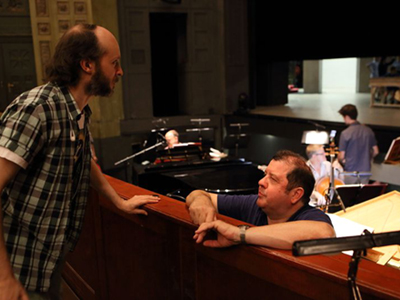
By ANDREW POWELL
Published: August 7, 2016
MUNICH — Two evenings after an “Allahu Akbar” eruption here cost nine mostly teenage, mostly Muslim, lives, it felt perverse to indulge in 280-year-old French escapism stretching to Turkey, Peru, Iran and the future United States.
But there we were July 24 in the Prinz-Regenten-Theater for Bavarian State Opera business-as-usual, a festival yet, and Rameau’s four-entrée Les Indes galantes as imagined by Sidi Larbi Cherkaoui, the Belgian choreographer with stage-director pretensions.
And safer we were, too, than at a smaller music festival 110 miles away near Nuremberg, the outdoor Ansbach Open, where a Syrian refugee denied asylum in this country was preparing to explode his metal-piece-filled backpack among two thousand listeners. (As luck would have it, Germany’s first suicide bomber killed only himself when he detonated only his detonator and did so outside the festival’s gates, not having known in advance he would need a ticket.)
Before departing for Turkey, the opéra-ballet states its premise by means of a prologue: European lovers pressed to exchange Goddess Hébé’s doux instants (sweet moments) for Goddess Bellone’s gloire des combats can count on intercession from a third god, Amour, as they “traverse the vastest seas” in military service.
This plays out with amusing dramatic variance* in the four locales to music of beguiling harmony and bold instrumental color, in airs, vocal ensembles, choruses and dances. The U.S. entrée concludes with the Dance of the Great Peace Pipe (penned after Agapit Chicagou’s 1725 Paris visit), minuets, a gavotte, and a most charming chaconne.
If you kept your eyes closed, the performance was a treat. Opening them invited confusion, or worse, despite Cherkaoui’s fresh dance moves, tirelessly executed by his Antwerp-based Compagnie Eastman.
Ivor Bolton and the Münchner Festspiel-Orchester, an elite Baroque pick-up band, served Rameau with verve and expressive breadth, ripe string sound and fabulous wind playing. The Balthasar-Neumann-Chor from Freiburg managed its musical challenges neatly, in opaque French.
The score’s 17 roles went to ten generally stylish soloists. Lisette Oropesa proved a graceful musician in the lyric soprano duties of Hébé and Zima. Anna Prohaska, as Phani and Fatime, stopped the show with a divinely phrased Viens, Hymen, viens m’unir. Light tenor Cyril Auvity sang artfully as Valère and Tacmas, while John Moore’s baritone lent a golden timbre to the sauvage Adario. Reveling grandly in the music’s depths were basses François Lis (Huascar and Alvar) and Tareq Nazmi (Osman and Ali).
But soprano Ana Quintans encountered pitch problems as Amour and Zaïre; Elsa Benoit, the Émilie, seemed squeezed by Rameau’s nimble turns; Mathias Vidal pushed harshly for volume in the tenor roles of Carlos and Damon; and bass Goran Jurić, in drag as Bellone, muddied her vital rousing words.
As for the staging, new on this night, conceit and a ruinous idea got the better of Cherkaoui (and BStO managers, who should have intervened if they care about Baroque opera as they profess): he would thread together the prologue and entrées into one dramatic unit. Characters would appear in each other’s sections, mute. Opéra-ballet form be damned.
In place of exotic lands (requiring exotic sets and costumes), the viewer would journey from schoolroom to museum gallery to church to flower shop, to no place, to some closed border crossing. The spectacle of Peru’s Adoration du Soleil, for instance, would unfold in the church. Woven throughout, clumsily, would be tastes of the plight of Europe’s present refugees, and Europeans’ poor hospitality. Count the ironies.
[*In Turkey a melodrama, as the shipwrecked lovers’ fate turns on Osman’s magnanimity (Le turc généreux). In Peru a tragedy, as the couple’s freedom results from Huascar’s molten-lava death (Les incas du Pérou). In Iran a bucolic, as two pairs of lovers ascertain their feelings through disguise and espial (Les fleurs, original version of Aug. 23, 1735). In the U.S. a comedy, as noble savage Zima flirts with and mocks two European colonists, reversing the pattern, before homing in on loving native Adario (Les sauvages).]
Photo © Wilfried Hösl
Related posts:
Portraits For a Theater
Nitrates In the Canapés
Harteros Warms to Tosca
Blacher Channels Maupassant
On Wenlock Edge with MPhil

Salzburg Coda
Friday, October 31st, 2014By ANDREW POWELL
Published: October 31, 2014
SALZBURG — Alexander Pereira is now gone from the main festival here, and two tenuous summers are in the offing before Markus Hinterhäuser replaces him as Intendant in 2017. His exit, under a cloud, ends a budget tempest but threatens reversals of worthy initiatives he took: lengthening the schedule to six weeks, deepening the commitment to sacred music, insisting on fresh stagings for opera. Pereira did not adapt to the old-boy (and old-girl) Salzburg bureaucracy but he restored an element of decisiveness that had been lacking since Karajan and later Mortier ran things. And despite fiscal overages and gripes about casting, his programs were a Karajanesque blend of tradition and vetted novelty, exemplified on three August days in the paired artistry of Vilde Frang and Michail Lifits; concerts by the Mozarteum-Orchester and the Academy of St Martin In the Fields; and new productions of Fierrabras and La Cenerentola.
Peter Stein, wise yet out of fashion, told Schubert’s 1823 Carolingian tale straight, using monochrome flats and simple lighting tricks to paint and speed between differentiated, handsome scenes (Aug. 22, Haus für Mozart). His target: the seated theater audience, not roving DVD cameras. He stressed Christian values of compassion and peace, contrasting the vehemence of the Moors; Fierrabras was Fierrabras, destined for conversion, not an impersonation of the composer. But coarse horn playing marred the presentation of a score much dependent on that instrument, and conductor Ingo Metzmacher tended to allow the Vienna Philharmonic winds to swamp the luscious strings, the orchestra to swamp the singers. Of the six principal roles, Julia Kleiter’s silvery-voiced Emma did the music fullest justice. The Vienna State Opera Chorus sang magnificently, also magically.
Taking for La Cenerentola the opposite but these days routine path, Damiano Michieletto deployed hard-surface, camera-friendly sets and updated Perrault’s story (Aug. 23 matinee, same venue). His homey cafeteria, “Buffet Don Magnifico,” buzzed with credible characters and tightly calibrated action; a startling scenic transformation added depth. Angelina, in her middle years, found love at first sight while busing tables, and goodness triumphed at the close through gifts to her wedding guests: rubber gloves, buckets and soap; as those guests were put to work, she blew bubbles. In a probable farewell to this signature role, Cecilia Bartoli (48) exerted feisty charm, her sound opulent, the vocal ornaments expressive and fresh as ever. Mirroring her comedic sincerity, Javier Camarena sang a stylish Ramiro and a modest one, too, until Sì, ritrovarla io giuro. This he peppered with loud highs and a long last C brightened in a timbral arc. The basso roles were contrasted: Enzo Capuano a bully of a Magnifico with lucid patter and smooth legato, Ugo Guagliardo a cupid-magician Alidoro of rich tones but somewhat graceless phrasing, and Nicola Alaimo a robust Dandini who overplayed his comic hand. Jean-Christophe Spinosi and the Brest-based Ensemble Matheus rose to the witty occasion.
Tour appearances by the 55-year-old London orchestra (same day, at the Felsenreitschule) haven’t always validated the high standards of its early records. This one did. Tomo Keller’s work as guest concertmaster blazed with virtuosity and seemed to ignite all desks. Although uncredited by the festival, he led Mendelssohn’s D-Minor Sinfonia (1822) by himself, finding elegance and mature ideas as well as precision in the four movements. Seven winds and conductor Murray Perahia then joined the 24 strings for an exceptionally refined reading of Haydn’s Symphony No. 77 (1782) filled with neat contrasts and fresh turns of phrase; the airy Andante sostenuto could have spun for an hour without losing appeal. After the break, Beethoven’s Fifth Piano Concerto (1809) emerged in fluid streams of sound, the rhetoric measured, the attacks vivid. Perahia deftly balanced poetry and drama, piano and orchestra, signaling with his arms when not occupied at the keyboard.
Ivor Bolton, beloved Chefdirigent of the Mozarteum-Orchester, sandwiched ardent arias of Gluck and Mozart between G-Minor Sturm und Drang symphonies (Aug. 24 matinee, Mozarteum), packing quite a punch. Resilient rhythms, vigorous angular themes and tidy dynamic shifts enlivened Haydn’s Symphony No. 39 (1765), capped by an Allegro di molto that expertly whirred along. In Mozart’s Symphony No. 25, written eight years later and inspired by the Haydn, Bolton elicited equal cohesion and propulsion, favoring tautness over repose, but the volume of sound pushed the limits of the 800-seat hall. Rolando Villazón brought astounding degrees of verbal expression and ample vocal luster to his three Mozart arias — Per pietà, non ricercate (1783), Or che il dover (1766) and, as vehicle for clowning, Con ossequio, con rispetto (1775) — buoyed and gamely resisted by Bolton and the orchestra. In Gluck’s Unis dès la plus tendre enfance, from Iphigénie en Tauride (1779), the tenor delivered the French words with operatic flair.
After the recital by Frang and Lifits (same day, same venue), one woman asserted aloud that Frang couldn’t possibly play the violin to full potential for lack of flow in her body movements, while another attendee bemoaned pianist Lifits’s gum-chewing facial mannerisms. What was certain was that two unique personalities had made music. They combined best in the pieces that opened and closed their program, Brahms’s Scherzo for the Frei aber einsam Sonata (1853) and Strauss’s similarly confident and classically formed E-flat Sonata (1888). Results: clear lines, passionate phrasing, ideal balances, a definite sense of structure. Lifits could be heavy in the left hand and seemed not always aware of his partner, but she proved able to enlarge her tone when she chose, adding volatility. The stylistic jump from Brahms to Mozart’s Violin Sonata in E-flat, K481 (1785), had the effect of Frang receding: Tashkent-born Lifits played as if on solid ground and the Oslo violinist looked happy to let him dominate, especially in the crisply articulated Allegretto. Beethoven’s A-Major Sonata, Op. 30/1 (1802), after the Pause, suffered slow tempos and a lack of drama.
Where the Salzburg Festival goes now, post Pereira, will be partly evident next month when the 2015 summer plans are announced. In all likelihood there will be cost-cutting to counter past overages, such as for 2013 when a reported $5 million went out the door beyond the approved $76 million. Once Hinterhäuser fills the Intendant void, the danger is of a well-bookkept but artistically dithering institution — a return, in effect, to qualities of the ten summers preceding Pereira’s 2012 arrival; Hinterhäuser, a pianist, participated in management for some of those years and is not known as a forceful character. The compass at present is with Sven-Eric Bechtolf, grandly styled “Artistic Master Planner 2015 and 2016” (a promotion from heading just the theater programming), and the festival’s indomitable Cost-Cutter-in-Chief, a.k.a. Präsidentin, Helga Rabl-Stadler.
Photo © Silvia Lelli
Related posts:
Nitrates In the Canapés
Mozartwoche: January’s Peace
Christie Revisits Médée
Netrebko, Barcellona in Aida
Pintscher Conducts New Music
Tags:Academy of St Martin In the Fields, Alexander Pereira, Bartoli, Beethoven, Brahms, Commentary, Damiano Michieletto, Ensemble Matheus, Enzo Capuano, Felsenreitschule, Fierrabras, Gluck, Haus für Mozart, Haydn, Helga Rabl-Stadler, Ingo Metzmacher, Ivor Bolton, Javier Camarena, Jean-Christophe Spinosi, Julia Kleiter, La Cenerentola, Markus Hinterhäuser, Mendelssohn, Michail Lifits, Mozarteum, Mozarteumorchester, Murray Perahia, Nicola Alaimo, Peter Stein, Review, Richard Strauss, Rolando Villazón, Rossini, Salzburg, Salzburg Festival, Salzburger Festspiele, Schubert, Sven-Eric Bechtolf, Tomo Keller, Ugo Guagliardo, Vienna Philharmonic, Vienna State Opera Chorus, Vilde Frang, Wiener Philharmoniker, Wiener Staatsopernchor, Wolfgang Amadeus Mozart
Posted in Munich Times | Comments Closed